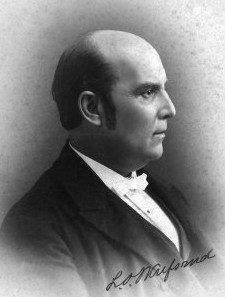
A little leaven, sometimes, goes a long way.
Lars Olsen Skrefsrud required a bit of leaven, that’s for sure. He was a rowdy young man, given to drink, carousing and petty thievery. By the time he was eighteen years old, young Lars found himself in prison. “My heart was as hard as a stone,” he said of those years. “It was dead, absolutely dead. I had turned my back upon God and plunged into riotous living…. I had suffered shipwreck in everything.”?[1]
But the leaven of God’s gospel was at work.
Skrefsrud had heard the Good News as a child from his deeply believing mother. He had heard the Good News preached in church and had been through confirmation. Now in prison, the testimony of a pious young woman from his home area, Anna Onsum, became particularly meaningful. Eventually Skrefsrud understood that Jesus had come into the world precisely for him. The blood of the Savior was sufficient to cover every sin, including – praise God! – his own. The year was 1861. The young imprisoned shipwreck became a new man.
And the leaven of God’s grace continued its work. While still a prisoner, Skrefsrud sensed “a burning desire to become a missionary… that I, the most unworthy of all, might be permitted to declare to the heathen what I had experienced in my own heart – His boundless compassion.”?[2] Skrefsrud gained his freedom in December 1861. By the summer of 1862, he made application for missionary service with the Norwegian Missionary Society.
That first application was rejected. (Young, passionate, prison-made converts were not so highly desirable, apparently.) Then a friend recommended that Skrefsrud consider alternative societies in Germany. Feeling led of God, he departed for Berlin in October 1862. There he met Hans and Caroline Borresen, who were to become his life-long friends and colleagues in ministry. The Borresens introduced him to the Gossner Mission. Skrefsrud enrolled in the Gossner Mission School, graduated quickly, and by November 1863 was on his way to India.
In the spring of 1865, the Borresens arrived in Calcutta to join the team – with Anna Onsum, by now Skrefsrud’s fiancée. (The two were married on May 6.) Later in the year, the Borresens and Skrefsruds set out in a strategic new direction – to serve among the Santal people, northwest of Calcutta. They left the Gossner Mission. On September 26, 1867, after several false starts, they laid a corner stone of “Ebenezer station” in the heart of Santalistan.
This was the beginning of the Santal Mission of Norway. But this was our beginning, too. An American Board of the Santal Mission was founded in Minneapolis on November 13, 1891. And this same board merged with the World Mission Prayer League on May 1, 1972. We are the Santal Mission, in fact. The leaven that worked in Skrefsrud is the leaven that works in us.
We have inherited much from these pious Scandinavian roots.
We have inherited a commitment to the urgent frontier between faith and unbelief. “To the poor [unbeliever] held captive in sin, I will cry: ‘You have a friend in Jesus,'” said Skrefsrud upon his departure from Norway in 1862.?[3] “The main thing was to save souls,” reported his biographer.?[4]
We have inherited a commitment to ministry holism. “Skrefsrud’s work for the economic and social improvement of the Santals is unique…. Practically single-handed he broke the power of the Hindu landowners, money-lenders and liquor dealers without neglecting the salvation of souls.”?[5]
We have inherited historical partnerships with the Northern Evangelical Lutheran Church of India and the Bangladesh Northern Evangelical Lutheran Church, as well as the Christian Hospital in Mohul Pahari and the LAMB Medical Project in Bangladesh.
Most of all, we have inherited a believing, Lutheran, evangelical appreciation for the gospel of God in the work of Christian missions.
It is the gospel of Jesus Christ that makes us believe and makes us missionaries. It is the gospel that calls us, prepares us, becomes our message and fuels our lives. Emotionalism cannot accomplish this, nor can sheer obedience. It is the objective gospel of Jesus Christ that creates life and empowers service within us.
An early promoter of the American Board heard Skrefsrud speak in Oslo in the summer of 1881. He concluded the message with a typical, gospel-centered emphasis: “It has proved true in my life; it will prove true in yours. If you will come to God today with your abounding sin, you can go out from here with his more exceedingly abounding grace as your possession.”?[6] “Exceedingly abounding grace” – this became the power, fuel, and message of the American Board.
A little bit of leaven – this kind of leaven – goes a very long way indeed. This is leaven for our entire community. We believe it is leaven for the world.
2 ibid., p.20
3 ibid., p.23
4 ibid., p.30
5 ibid., p.45
6 The American Santal Mission, by Andreas Helland, p. 9. (Minneapolis: Santal Mission in America, 1948)